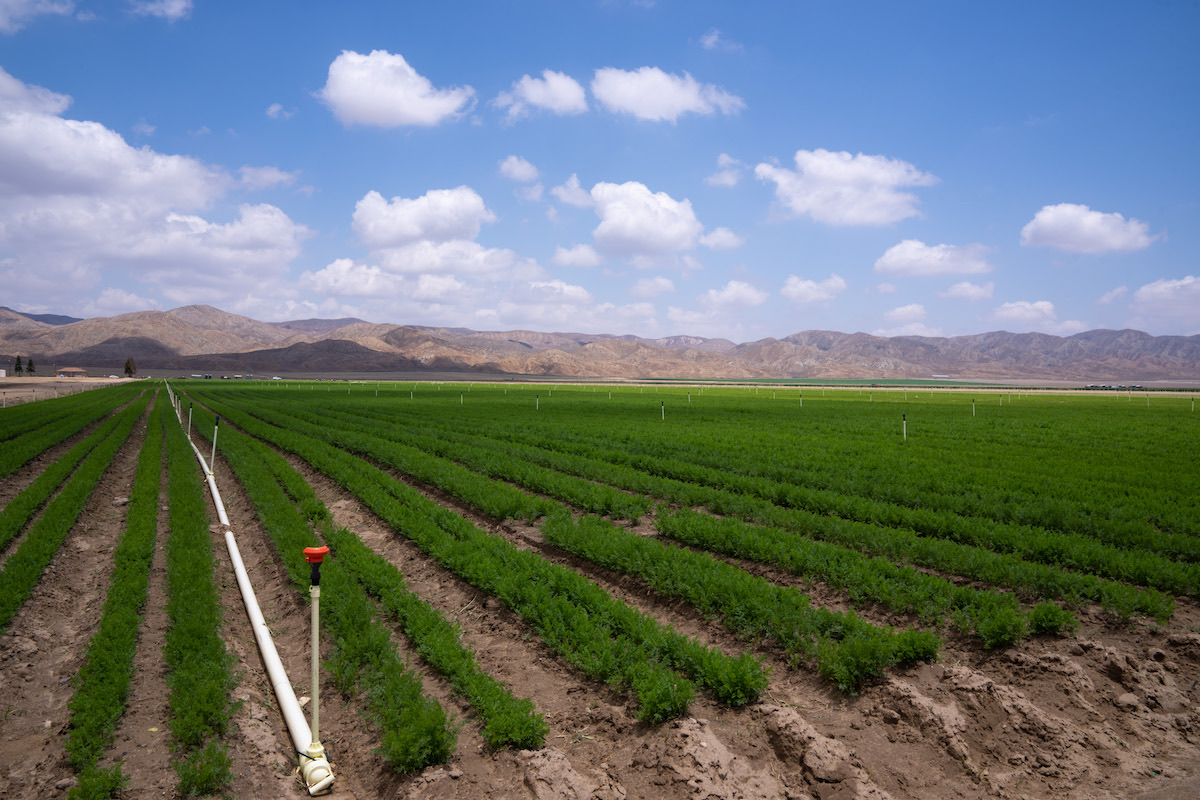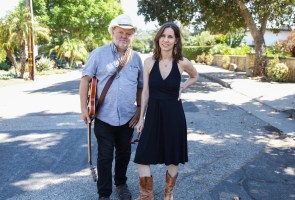Draining Groundwater and Pocketbooks in the Cuyama Valley
Water Rights Lawsuit by Cuyama Carrot Corporations is Driving up Legal Fees and Gumming up Plans for Sustainability

It’s been nearly 10 years since the Sustainable Groundwater Management Act was signed into law in California, launching a historic effort to halt the headlong decline of the state’s most depleted underground water basins.
The state law, dubbed “SGMA” and pronounced “Sigma,” triggered the formation of groundwater sustainability agencies that, in concert with their communities, developed schedules of mandatory pumping cutbacks to bring their basins back into balance by 2040, the deadline set by the state.
That was the easy part. Now, the law has entered a period of reckoning. Water rights lawsuits have been filed in 10 regions, challenging both the cutback plans and the authority of the agencies that drew them up.
Ground Zero in this courtroom battle is the Cuyama Valley, a vast, dry agricultural region east of Santa Maria, where the world’s largest carrot corporations are pitted against 30 much smaller farms, a few longtime cattle ranchers and a low-income community of more than 1,200 people.
On June 21, at the Cuyama Valley Family Resource Center in New Cuyama, after a home-cooked meal of pozole with all the trimmings, a group of valley farmers, ranchers, water district managers, school leaders and owners of small businesses held a “listening session” with state lawmakers and water officials. They talked about their declining well water, their rising legal fees and what they view as the loopholes in the law.
“We hope you will walk away thinking about our valley and how to help us,” Ella Boyajian, an olive farmer and one of the event organizers, said.
County Supervisor Das Williams, who represents the region, reminded the lawmakers present — state Sen. Monique Limón (D-Santa Barbara), state Sen. Melissa Hurtado (D-Bakersfield) and state Assemblyman Gregg Hart (D-Santa Barbara) — that well water is the valley’s only source of water.
“In all my time in politics,” he said, “I have never seen a community that fits the historical definition of a colony more than this community, in that the people who have the real power over it do not live here and are extracting things from it.”
“Power Dynamics”

During 2023, an abnormally wet year, Bolthouse Farms and Grimmway Farms, the global carrot companies, pumped 20,060 acre-feet of water out of the valley’s groundwater basin, an amount equal to a two-year supply for Santa Barbara, population 88,000, records show. In 2022, a dry year, they pumped the equivalent of nearly a three-year supply for the city onto their carrot fields. The two corporations are drawing well water from as far down as 600 feet underground.
Under a plan developed by the Cuyama Basin Groundwater Sustainability Agency (GSA) and approved by the state Department of Water Resources, Bolthouse and Grimmway could be required to reduce their pumping by as much as two-thirds by 2040. Currently, the cutbacks — a 5 percent reduction this year, increasing to 6.5 percent yearly in 2025 — are confined to the flat central portion of the basin, where the carrot fields along Highway 166 extend as far as the eye can see.
Two past and present executives of Bolthouse and Grimmway serve on the 11-member GSA board and signed off on the schedule of pumping cutbacks. But, since 2021, the corporations’ landlords — Bolthouse Land Co. and Grimmway’s land management companies — Diamond Farming, Lapis Land Co. and Ruby Land Co. — have embroiled every other property owner in the valley in a water rights lawsuit known as an adjudication.
“They called it a friendly lawsuit,” Boyajian said. “It didn’t feel friendly to us. SGMA is a collaborative process. Now we have an adjudication which is encouraging self-interest. And the conflict of interest on the GSA is very frustrating to the community,”
The plaintiffs seek to spread the pumping cutbacks equally to farmers throughout the basin. They have said they are not seeking cutbacks for water districts, schools or small users, though they have all water users in the valley as defendants in the case. A Los Angeles Superior Court judge will ultimately decide how much water each property owner is entitled to pump.
“We have the power dynamics of David and Goliath — an outsized set of resources versus a disadvantaged community,” said Brenton Kelly, a Ventucopa permaculture farmer who chairs the GSA’s advisory committee. “It seems unlikely that Cuyama will ever recover to the conditions of even 10 years ago when the law was written.”

“A Pall over the Valley”
Kelly told the visitors to their remote valley that they had had seen no significant decrease in groundwater pumping to date, despite $16 million spent by the GSA since 2017. Farmers, ranchers and water districts said their legal bills in the adjudication were unsustainable, with no end in sight. They said it was not fair that a Los Angeles judge should decide their water future.
Kelly described the water rights adjudication as a “thick molasses” that was “highly duplicative” of work already done by the state and the GSA. This February, for example, after more than two years of legal wrangling over the boundary of the 380 square-mile basin, the judge simply recognized the boundary that had been previously delineated by the state. That was Phase 1 of the trial.
“SGMA has failed us, in a way,” said Robbie Jaffe, an advisory committee member who dry-farms wine grapes and olives on five acres in the foothills at the western end of the valley. Jaffe said she had paid $10,000 in legal fees to date.

Pam Doiron, whose family owns and operates the Spanish Ranch, a large cattle, wheat and barley operation on Highway 166 west of Cuyama, told the elected officials that the lawsuit had “thrown a pall over the valley” and was “sucking all the profit out of our operations.”
“If we have our water use cut because of the adjudication, there will be no way to keep ranching,” she said.
Dave Lewis, a GSA advisory committee member and self-described “gentleman farmer” with 40 acres of pistachios at the eastern end of the valley, and said he was using drip irrigation and was not responsible for the declining water levels underground.
“It’s the big pumpers,” he said, adding that driving into the valley in the evenings, he often sees “ditch water” along the road for two miles at a stretch — a sure sign of over-irrigation on carrots.

“I could water my property probably two years with what’s running down the ditch,” he said.
Lewis said he had spent $50,000 in legal fees to date on the adjudication, adding: “I’ve never felt like a victim, but I do now. I never had a lawyer until I moved to the Cuyama Valley.”
Alfonso Gamino, superintendent of the Cuyama Joint Unified School District, said the district had been “unexpectedly burdened” with $28,600 dollars in legal fees that could have been spent on books and computers. Rosalba Fonseca, a longtime New Cuyama resident, spoke about the high cost of water in town: the water and sewer district has assessed a $20 surcharge on all customers — a 10 percent increase on an average $206 bill — to pay its legal fees for the adjudication.
Laura Price, the owner of a hardware store on Highway 166, fought back tears as she told how the Cuyama Mutual Water Co., serving five homes and three businesses in “old” Cuyama, east of New Cuyama, had had to take $8,000 from its emergency fund for legal fees.
“I get emotional,” Price said. “That’s a huge hit … I’m the one who has received many phone calls from crying residents. It’s not only farmers and ranchers who are affected by this.”

“Tip of the Spear”
In response, Sen. Limón told the gathering: “We have a complicated policy issue in front of us. We’re trying to find a fix, and it’s hard … We are walking out with a profound sense of the challenges you have. We hear it in your voice. It’s not lost. It doesn’t go away.”

Paul Gosselin, deputy director of the state Department of Water Resources, assured residents that the state was a partner of the GSA and the community, but, he said, “SGMA, at this point, is starting into the most difficult period. This is where the rubber hits the road.”
“We want to preserve what was the promise of SGMA about local control and bringing basins into balance. It seems like you’ve been in court and talking to attorneys a lot. I’m sorry about that.”
Gosselin told residents that profound changes are coming in the way that water is managed, and he said, “You’re at the tip of the spear … You’re doing this, as difficult as it is, for future generations.”
Williams urged those present to support the carrot boycott against Bolthouse and Grimmway that valley residents launched last fall. To date, about 9,400 people have signed an online boycott petition, but organizers said it was hard getting people outside the area to join. They are asking the companies to stop over-pumping valley groundwater, drop their lawsuit and reimburse residents for their mounting legal fees.
“That is one of the ways that his David, this colonized community, can pick up a stone and hit the head of a giant,” Williams said.
“Politically Driven”
Phase 2 of the trial is set for February 24, 2025 and will determine the “safe yield” of the valley’s groundwater basin. It is expected to last two or three weeks. The state has defined safe yield as the maximum amount of water that can be pumped out annually “without causing an undesirable result.”
At issue is whether the “safe yield” determined by the judge will be larger than the “sustainable yield” set by the Cuyama GSA. The GSA has argued that the sustainable yield takes into account not only the declining groundwater levels, but also the water quality of the basin, and the groundwater that is connected to creeks and springs.
Bolthouse Land and Grimmway’s land managers contend that the agency’s sustainable yield estimate of 20,000 acre-feet per year for the basin is “politically driven.”
“It is critical to all groundwater users that a safe yield that is scientifically supportable and fact-driven be determined by the court,” Dan Clifford, general counsel for Bolthouse Land, stated in an email last week.
Bolthouse and Grimmway alone pump more than 20,000 acre-feet of water out of the basin every year. In 2021, a drought year, all basin pumpers together extracted 64,000 acre-feet of water, or more than three times the sustainable yield. In 2023, a very wet year, basin-wide pumping was nearly 50,000 acre-feet. In any given year, about 40 percent of the pumping irrigates Bolthouse and Grimmway carrots.

Phase 2 of the water rights trial is expected to take two or three weeks. In later trial phases, court documents show, the plaintiffs will argue that confining mandatory cutbacks to the central basin where Bolthouse and Grimmway operate would constitute a 90 percent reduction in pumping and farming; and would be “severely detrimental” to them and other farmers “while the rest of the basin continues to prosper with unregulated pumping.”
The basin will not achieve sustainability “unless all groundwater users share proportionally in pumping reductions,” Clifford said. “… All farming interests in the basin must reduce their pumping.”
Robert Kuhs, an attorney for Grimmway’s land management companies, said in an email: “The lack of regulated pumping in a significant portion of the basin inhibits sustainability and disproportionately impacts certain landowners.”
Farmers outside the central basin say they didn’t cause the severe overdraft there and shouldn’t be required to reduce their pumping to the same degree as Bolthouse and Grimmway, if at all. It would be unfair to treat everybody the same, they say, when the carrot operations bear the most responsibility for creating the problem in the first place.
The GSA advisory committee has asked the board to come up with a more nuanced “tiered approach” to cutbacks that would target the hot spots of groundwater decline for the largest cutbacks, Kelly said. Farmers, he said, should “be a solution with relevance to how much they’re part of the problem.” But the board has not taken up the idea.
“If the regulations could recognize the vast differences in sustainability and overdraft throughout the basin,” Kelly said, “then people could get behind that. But it’s never been an option.”
As for the legal fees that valley residents are paying, Clifford and Kuhs noted that during Phase 1 of the trial, some landowners — not their clients — contested the basin boundary as established by the state. They included the Harvard Management Co. at the western end of the valley; and a group of Ventucopa orchard farmers at the eastern end, one of whom is a GSA board member. They ultimately withdrew their objections, Clifford said, but they “unfortunately ended up costing every groundwater user in the basin unnecessary money and time.”
“We have repeatedly confirmed to the court and the citizens of Cuyama Valley that we are not seeking to reduce the availability of groundwater to local water districts, school districts and small non-farming property owners,” he said.
To reach an expeditious resolution of the case, Clifford said, “We have represented to the court that we are in favor of mediating this matter …”
“Better than Nothing”
In addition to the Cuyama Valley, property owners in Borrego Springs, Indian Wells Valley, Oxnard, Ojai Valley, Upper Ojai Valley, Upper and Lower Ventura River and Las Posas and Pleasant Valley in Ventura County have filed water adjudication lawsuits in the wake of SGMA.
In the past, water rights cases have been based on historical water use, which favors big pumpers, not small farmers who may be more conservation-minded. No one knows whether the judges deciding these cases will be sensitive to the rules governing groundwater sustainability. SGMA merely says that an adjudication cannot “substantially impair” state or GSA efforts to bring groundwater basins into balance.
AB560, a bill sponsored by state Assemblyman Steve Bennett (D-Ventura) would require the parties to any proposed settlement agreement in an adjudication to submit their proposal to the state Water Resources Control Board before the judge makes a ruling.
After consulting with the Department of Water Resources, the board would make a non-binding determination as to the proposed settlement’s consistency with the local GSA plan and its likely impact on “small and disadvantaged groundwater users.” The parties to the adjudication would be required to submit the board’s findings to the court along with their proposed settlement.
In an interview this week, Bennett said that his bill was “the most I could get approved up to this point in time … It’s just an advisory opinion, but it’s far better than nothing.”
The bill narrowly passed the Assembly last year and is now sitting in a state Senate committee, where its fate is uncertain.
“The water world is very powerful,” Bennett said. “There’s a tendency for them to stick together. They lobby to block any bill, even if it doesn’t affect them at all.”
The Cuyama Valley, Bennett said, “will quickly show us what the flaws in the law were … It’s going to be an example of how slowly they’re requiring implementation, and how much conflict of interest they created in their governing board.”

Cuyama Dreaming
After the June 21 lunch meeting, some of the participants took a tour of Cuyama Homegrown, a one-acre orchard and vegetable farm at 1381 Foothill Road, in south of “old” Cuyama. The farmers, Jean Gaillard and Meg Brown, sell their produce to a small group of valley residents, the Cuyama Buckhorn restaurant, and the farmers market in Santa Maria. Most valley residents must drive to Bakersfield or Santa Maria to buy fresh produce.
Gaillard, a member of the GSA advisory committee, showed off the farm’s water tanks, which are filled with stormwater runoff from the roofs of farm buildings. He pointed out the regenerative techniques he and Brown have adopted, such as using oats and peas as cover-crops to “fix” the nitrogen in the soil and prevent the ground from baking in 100-degree weather.

“We’re trying to prove that in the high desert of Cuyama, you can grow valuable crops with a little amount of water,” Gaillard said. “ We make nature work for us. Water is a precious resource and it is not unending. Sometime, the bucket will be empty.”
Jaffe and Kelly talked about how, in the “food desert” of the valley, perhaps a “mobile market” could someday reach the far-flung businesses and residential communities, bringing them fresh produce from a farm-to-table network of small farms such as Cuyama Homegrown.
“A lot of us are looking down the road,” Jaffe said. “At some point, these companies are going to have to pull out … I feel like we’ve been in this war for 10 years. It’s time we start dreaming things.”
Melinda Burns is an investigative journalist with 40 years of experience covering immigration, water, science and the environment. As a community service, she offers her reports to multiple publications in Santa Barbara County, at the same time, for free.
Premier Events
Fri, Jan 31
5:00 PM
Santa Barbara
Artist Talk at Art & Soul on State Street
Wed, Jan 22
5:30 PM
Santa Barbara
Talk: “Raising Liberated Black Youth”
Sun, Jan 26
11:00 AM
Santa Barbara,
17th Annual Santa Barbara Community Seed Swap 2025
Thu, Jan 30
8:00 PM
Solvang
Lucinda Lane Album-Release Show, at Lost Chord Guitars
Fri, Jan 31
9:00 AM
Goleta
AARP FREE TAX PREPARATION
Fri, Jan 31
5:00 PM
Santa Barbara
Artist Talk at Art & Soul on State Street
Sat, Feb 08
10:00 AM
Santa Barbara
Paseo Nuevo Kids Club
Sat, Feb 08
12:30 PM
Solvang
Garagiste Wine Festival
Tue, Feb 11
8:00 PM
Santa Barbara
SBIFF – Tribute to Timothée Chalamet
Thu, Feb 13
8:00 PM
Santa Barbara
SBIFF – Tribute to Adrien Brody and Guy Pierce
Fri, Jan 31 5:00 PM
Santa Barbara
Artist Talk at Art & Soul on State Street
Wed, Jan 22 5:30 PM
Santa Barbara
Talk: “Raising Liberated Black Youth”
Sun, Jan 26 11:00 AM
Santa Barbara,
17th Annual Santa Barbara Community Seed Swap 2025
Thu, Jan 30 8:00 PM
Solvang
Lucinda Lane Album-Release Show, at Lost Chord Guitars
Fri, Jan 31 9:00 AM
Goleta
AARP FREE TAX PREPARATION
Fri, Jan 31 5:00 PM
Santa Barbara
Artist Talk at Art & Soul on State Street
Sat, Feb 08 10:00 AM
Santa Barbara
Paseo Nuevo Kids Club
Sat, Feb 08 12:30 PM
Solvang
Garagiste Wine Festival
Tue, Feb 11 8:00 PM
Santa Barbara
SBIFF – Tribute to Timothée Chalamet
Thu, Feb 13 8:00 PM
Santa Barbara




















You must be logged in to post a comment.